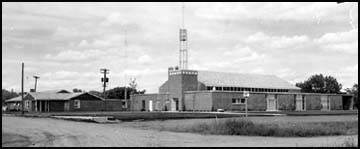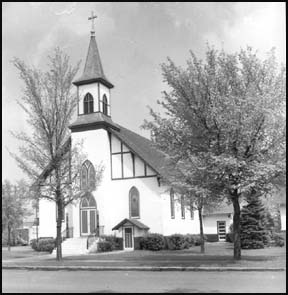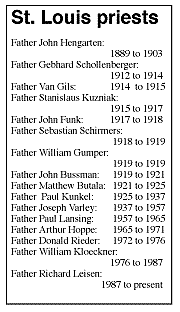 A new church was not the primary focus of Father Varley's efforts. He wanted to construct a parochial school on property purchased in 1957. Ground was broken in 1959 for a new church with the school to be added at a later date.
A new church was not the primary focus of Father Varley's efforts. He wanted to construct a parochial school on property purchased in 1957. Ground was broken in 1959 for a new church with the school to be added at a later date. Members, past and present, will be attending the 100th anniversary cele-bration of St. Louis Catholic Church, Paynesville, on Sunday, Aug. 22, to reminisce about various events of the church and to catch up on old times with former priests.
Members, past and present, will be attending the 100th anniversary cele-bration of St. Louis Catholic Church, Paynesville, on Sunday, Aug. 22, to reminisce about various events of the church and to catch up on old times with former priests. "Celebrating Our Faith... past, present, and future" is the theme for the centennial celebration.
St. Louis Catholic Church will be celebrating with their regular mass schedule (8:30 and 10 a.m. on Sunday) and a special mass at 1:30 p.m. and an open house at 2:30 p.m.
At right, the second St. Louis church on Augusta Ave. and Hwy. 23; currently the American Legion Clubrooms.
Parish members have been busy gathering together old pictures commemorating events of the church and have compiled a history book. Below is a history condensed from the book.
The church was first organized in April 1899, when a notice was published in the Paynesville Press asking all catholics and noncatholics of Paynesville and New Paynesville and vicinity that are interested in building a church to meet in Dr. Pilon's office.
"Those who attended mass elsewhere that day had the long trip still fresh in their minds, while those who didn't get to church because of travel difficulties had their desires still warm," the Press stated.
The group moved quickly, documenting sufficient population, funds, and leadership. A month later on May 29, 1899, St. Louis Parish was incorporated by Bishop James Trobec of the Diocese of St. Cloud.
According to the early history of the church, the name was decided upon by a vote between the French and Irish. Each vote was worth 10 cents. The two names on the ballot were St. Rose and St. Louis.
Legend attributes the naming of the church after the patron saint whose ethnic group raised the most funds with the Irish topped by the French; $85 was raised for the church.
The first church structure was a frame building moved to the church lot (near the present American Legion site on Augusta Avenue) in June 1899. John Hood crafted the church's first altar. Money for a statue of St. Louis was collected by Mrs. Leo Hartmann and the bell came from fund raising efforts of Mr. and Mrs. Paul Fuchs.
Bishop Trobec assigned Father John Hengarten, a priest familiar to the Paynesville area families, as pastor. He was based in Eden Valley with Belgrade and Paynesville as his mission. Mass was held once a month in Paynesville.
The mission status of the parish changed in 1912 when three men of the parish approached Bishop Trobec, asking for regular weekly mass. Within a few months of their visit, weekly mass was being offered at the church with Father Gebhard Schollenberger coming from St. Patrick's Church in Minden Township. He had to travel more than 30 miles to offer mass in Paynesville.
On Feb. 12, 1912, Father Schollen-berger called a special meeting of the parish to make a decision on building a new church. The new church was built just west of the old church building. The old church was eventually sold and moved from the property.
The exact date the new church was first used is not recorded in any parish documents. It is believed to have been finished just prior to confirmation ceremonies in November of 1913.
In 1915, Father Stan Kuzniak came for a few months from St. Patricks. A meeting was held to ask if the parish could raise a little more money and have a resident priest. It was voted to add $5 to each member's assessment and so the first resident priest came to Paynesville in 1916. A house was rented at $12 a month for Father Kuzniak.
Father Funk was the second resident priest in Paynesville. He continued to take care of the church at Brooten twice a month. He gave up the first rental house and moved into another house two blocks northwest of the church. Taking care of missions in those days was hard compared to the present. It meant leaving Paynesville at 2 p.m. Saturday and living at a hotel waiting for a chance to get home by train which was from 2 to 4 a.m. Monday morning or by late afternoon.
After becoming disgusted with bad train connections between Paynesville and Brooten, Father Funk read about a secondhand Ford offered for sale. He called the dealer and was asked why not a new one. In 15 minutes, Father Funk owned a new Ford car, becoming the first motor-driven pastor at St. Louis Catholic Church.
Father Sebastian Schirmers started serving St. Louis parish in November of 1918. Although Father Schirmers is credited with getting the parish back on firm financial footing following the lean years of Father Funk, any advancements he made are overshadowed by the fact that the parish lost its resident priest while he was in charge. Within one year of his coming to Paynesville, he left the rented house provided him by the parish and moved to Brooten.
Through Father Schirmers' ingenuity, a much needed basement was dug under the church in 1919 at no cost to the parish. The work was done entirely with volunteer labor.
For six years following Father Schirmers' move, St. Louis parish was served as a mission church by priests from neighboring communities.
The days of being a mission church ended in 1925 with the arrival of Father Paul Kunkel. It was obvious from the beginning that Father Kunkel liked Paynesville, especially its enthusiasm for baseball games. An avid sportsman, Father Kunkel joined the town baseball team and could be found Sunday afternoons running bases on the local field.
Within months of his arrival, Father Kunkel asked the St. Cloud Diocese for permission to leave Kimball and take up residence in Paynesville. He wanted St. Louis to be his only assignment. Bishop Joseph Busch gave permission for the move and eventually became the first priest in the parish's history to serve full time. However, the bishop did not immediately relieve Father Kunkel of his responsibilities of serving the Kimball church.
A milestone for the parish came in 1928 when a rectory was built for Father Kunkel next to the church. Prior to the construction of the rectory, Father Kunkel stayed with parishioners. Veronica Kost recalls Father Kunkel staying with her family during his first years in Paynesville.
Father Kunkel left Paynesville in 1937 when he was assigned to the Donnelly church. In exchange, Father Joseph Varley moved to Paynesville from Donnelly. Father Varley had just been released from the St. Cloud Hospital when the bishop's reassignment was announced. It was determined that Father Varley was not well enough to return to the remote Donnelly parish and he would do better with a parish closer to St. Cloud Hospital.
The arrival of Father Varley marked the beginning of a new era of ecumenicism not only for St. Louis parishioners but for the entire city of Paynesville.
Veronica Kost, in the centennial book, recalls Father Varley mixed with everyone. He eagerly joined his protestant counterparts in the formation of the Paynesville Ministerial Association, something which Catholic priests in other parts of the diocese would not have considered doing at that time.
By the time Paul and Irene Hemmesch moved to Paynesville in 1941, the membership list was growing quickly at St. Louis Catholic church. Attendees were seated on the side wall benches, chairs, stairways, and in the vestibule.
By 1949, the parish membership had grown to 115 families and the need for more worship space was obvious. Whether to expand the present church in downtown Paynesville or build an entirely new structure on another site was debated over many years.
 A new church was not the primary focus of Father Varley's efforts. He wanted to construct a parochial school on property purchased in 1957. Ground was broken in 1959 for a new church with the school to be added at a later date.
A new church was not the primary focus of Father Varley's efforts. He wanted to construct a parochial school on property purchased in 1957. Ground was broken in 1959 for a new church with the school to be added at a later date.
The new church built in the late 50s and first used in 1960. It has since been added on to and remodeled. This church can be seen from Hwy. 55 on Burr and Main streets.
Father Paul Lansing came to the parish in 1957. It was part of his job to see that the church was built. In a book he wrote, Father Lansing said the parishioners debated over several plans and building sites. "Some people of the parish wanted me to put the blueprints we had into the ash can. I had to use my influence," he wrote. This resulted in the building being constructed on property purchased during Father Varley's tenure.
In February 1960, first mass was held in their long-awaited new sanctuary. The completed church and parish hall measured 130 feet long and 88 feet wide.
Father Lansing's service to the church ended abruptly when he suffered a severe stroke in 1965.
Father John Braun was substitute priest for the parish until a new priest could be assigned.
 Father Arthur Hoppe came to Paynesville in November of 1965. During his tenure, the parish paid off the building debt.
Father Arthur Hoppe came to Paynesville in November of 1965. During his tenure, the parish paid off the building debt.
Father Donald Rieder came to St. Louis in 1971. In January 1972, he presented a list of goals to the parish. The list included a parish council, eucharistic ministers, women lectors, and establishment of a parish mission.
As ambitious as this list seemed to the parish, almost all of the goals were realized before Father Rieder left the parish in 1976.
Also in 1972, Father Rieder started some building improvement and renovation projects: a new tabernacle and stand, communion stations, renovated baptismal font and area, new lecterns, to name a few.
From the first time he spoke as the new pastor of St. Louis in July 1976, Father William Kloeckner made a profound impression on parish members. Born in Germany, the new priest spoke with a thick German accent. Understanding Father Kloeckner was a struggle, at first, for many.
During his tenure, the church's 20-year-old building started needing repairs and upgrading. Improvements included taking out two sections of the south wall to make the sanctuary more visible to people seated in the parish hall, building a choir loft and "cry" room, and installing stained-glass windows.
Parishioners have not forgotten Father Kloeckner's entrance at his final weekend masses at St. Louis in 1987. He entered the church riding his new golf cart down the church aisle at each mass. The parishioners laughed and applauded his entrance.
Father Richard Leisen replaced Father Kloeckner in 1987. He had advance meetings with Father Kloeckner to familiarize himself with the church finances, programs, and existing staff. Father Leisen had a smooth start. The first thing he did upon his arrival was to meet as many parishioners as possible.
Father Leisen learned that a first priority would be to begin planning for a building expansion program.
Ground was broken on May 1, 1988, for an education center and parish hall. This resulted in a new main entrance coming in from the south.
The reorientation and renovation of the worship space increased seating from 345 to 650. The new parish fellowship hall increased the dining area from 240 seating to 350.
A mass and dedication ceremony was held on Aug. 27, 1989, for the new addition.
St. Louis music
The church's first organ was purchased in 1902. The first organized church choir was started by Father Kuzniak in 1915. Practices were held in the homes of choir members.
Practices after 1928 were held in the parish house during the winter months and in the summer, practice was in the choir loft.
Forty-five years of music at St. Louis Catholic Church has produced many talented choir directors, musicians, and singers.
In 1944, Michael and Jeanette Waldorf got involved. Changes in the church music program that took place that year under their direction included a reorganization of the adult choir and Jeanette Waldorf starting as church organist, a position she held for 51 years.
Prior to the Waldorf's involvement, the music was directed by J.J. Manthey and his daughter, Margaret. They drove into Paynesville every week from Regal. Margaret directed the junior choir and played the organ. In 1937 Margaret Manthey formed the children's choir.
In 1959, a pipe organ was purchased by the parish. The organ is still in use.
Over the years various choirs have been formed. Among them are: the boys and girls choir, junior choir, young adult choir, all girls choir, children's choir, youth choir, Renew Choir, and Rejoice Choir.
Youth groups
Students attending religious education classes and singing in church choirs, and boys serving at mass existed as the only contacts between the parish and its youth for the first 50 years of the church's existence.
In 1949, an organization was formed to involve senior high school students in church activities.
Various youth activities, outside of religious education classes, are recorded beginning in 1978 when a young people's mass was conducted. A mini-retreat for youth in grades 10 through 12 was held in November of 1978.
In October 1981 the St. Louis Saints, a youth group for senior high students was formed. Their first activity was a pizza party.
Another youth group for the fifth through eighth grade students was started in January of 1984. The group was called JELLO (Jesus' Everlasting Love Lives On).
Mission groups formed
In 1951, Little Flower Mission Group was the first group formed at St. Louis Catholic Church. The organization's purpose was "doing mission work for the Society for the Propagation of the Faith."
Monthly dues were 25 cents and a penny dish was used for mass intentions. For many years members of the Little Flower Mission Group crocheted caps for newborn babies at the Paynesville hospital. They also made quilts which were given to local fire victims.
Father Varley's influence on the continuation and expansion of the number of mission circles was felt during his years as pastor. He wrote in a Sunday bulletin that serving expensive lunches and attending meetings was not necessary to doing mission work. All that is needed is to pay the membership dues of 25 cents a month. He also suggested that meetings were not necessary. Leaders could simply contact members by telephone or letter about projects that needed to be done.
Father Varley added that he would like to see every married lady, young and old, belong to a mission circle.
In 1978, men entered the mission picture, which had been traditionally a woman's domain with the formation of St. Isidore's Mission group. "We enjoy the men with us," said Miranda Hemmesch. "It makes an exciting card game."